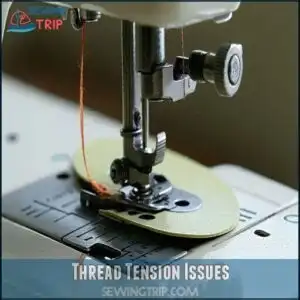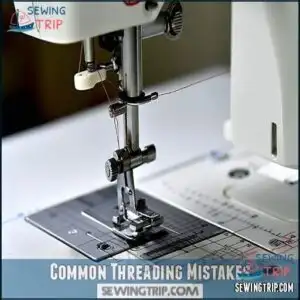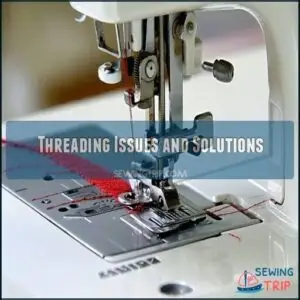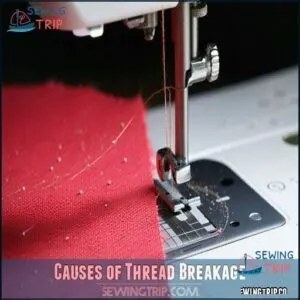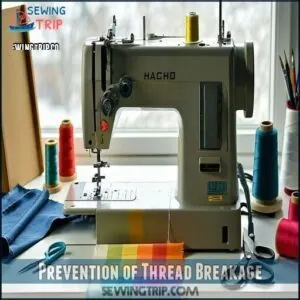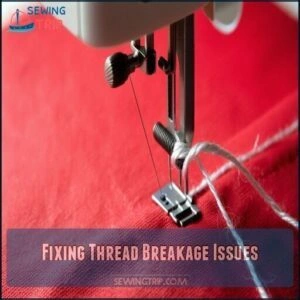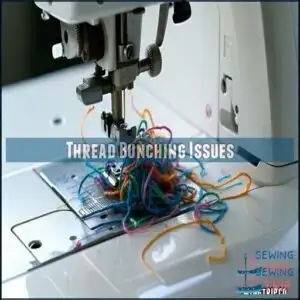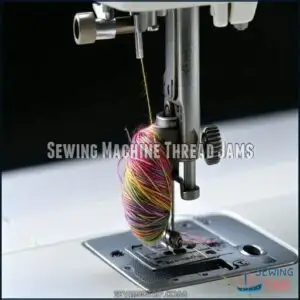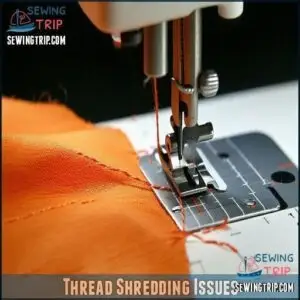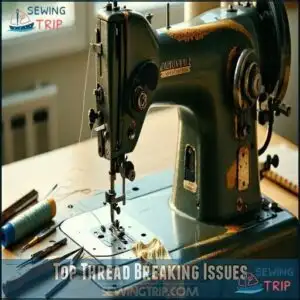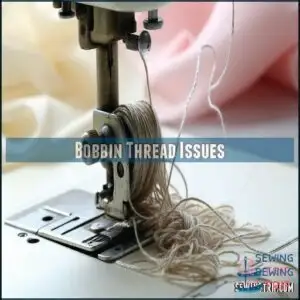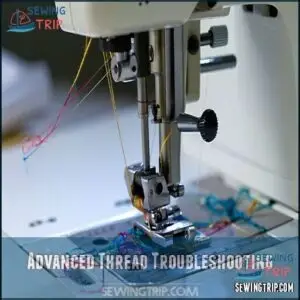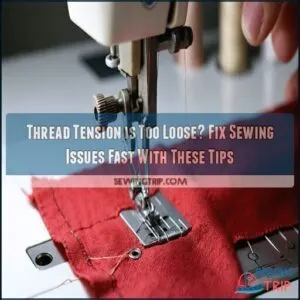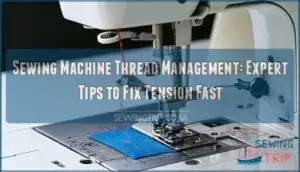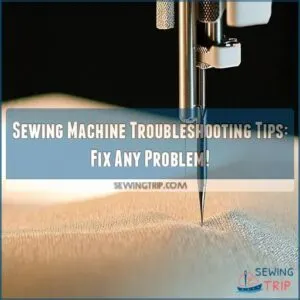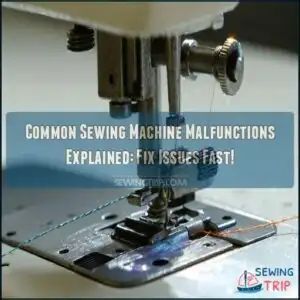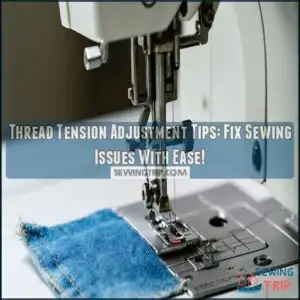This site is supported by our readers. We may earn a commission, at no cost to you, if you purchase through links.
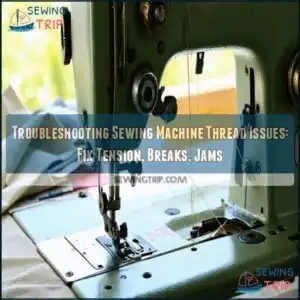
Start by double-checking your threading—it’s surprisingly easy to miss a guide. Tension troubles? Verify the top thread and bobbin tension balance like a good handshake—too tight or loose, and things fall apart.
If threads are snapping, check for a burr on the needle or switch to a higher-quality thread. For jams, clean lint from the bobbin area—it’s like flossing for your machine.
Fixing these basics usually clears things up, but there’s always a little more to the story, and addressing these issues can help resolve tension troubles and prevent threads from snapping.
Table Of Contents
Key Takeaways
- Re-thread your machine with the presser foot up to avoid skipped stitches, tangles, or tension issues.
- Clean your sewing machine regularly to remove lint and debris that can cause jams and thread breaks.
- Adjust thread tension carefully and test on scrap fabric to get balanced, smooth stitches.
- Use high-quality thread, the right needle size, and proper bobbin placement to prevent breakage and bunching.
Thread Tension Issues
If your stitches are uneven or your fabric puckers, your thread tension might be the culprit.
Don’t worry—it’s easier to fix than you think, and a few adjustments can get your machine sewing smoothly again.
A few simple tweaks can transform frustration into flawless stitching—keep your sewing machine running smooth and hassle-free!
Causes of Thread Tension Problems
Thread tension problems arise from mismatched threads, incorrect settings, low-quality thread, or bobbin tension issues.
Needle problems and machine damage, like nicks on the throat plate, also disrupt tension.
If your sewing machine’s thread tension feels off, check for improper threading or dirt buildup.
Neglecting tension adjustment is like driving with a flat tire—everything goes off balance, which highlights the importance of regular checks to prevent issues like machine damage.
Effects of Improper Thread Tension
Improper thread tension affects your sewing machine in frustrating ways.
Seam puckering on lightweight fabrics, looped stitches underneath, or even fabric damage can ruin your work.
Uneven tension often pulls threads in the wrong direction, causing thread breaks and weak seams.
These thread tension problems require attention fast—fixing tension keeps your stitches balanced and your projects smooth.
Checking and Adjusting Thread Tension
When thread tension problems strike, it’s time for action. Start by tweaking the tension dial settings gently—small moves make a big difference.
Check the bobbin case adjustment for any hiccups. For consistent results, match thread weight to your fabric. A precise thread tension gauge guarantees the best sewing.
Always:
- Re-thread your sewing machine.
- Adjust tension settings slowly.
- Test on scrap fabric.
- Clean tension discs.
- Review tension troubleshooting tips.
Threading Sewing Machine
If your machine isn’t threaded correctly, you’re almost guaranteed to run into skipped stitches, tangles, or outright jams.
Following the right threading steps may feel tedious, but it’ll save you endless frustration down the line.
Proper Threading Techniques
Getting threading right starts with these basics: check spool placement and verify the thread path is clear.
Follow the threading order in your manual and use thread guides properly.
Feed the thread smoothly through tension discs and test with gentle pulls.
For bobbin winding, maintain even tension—no bobbin tangles allowed.
Many sewers find it helpful to explore specific machine models for optimized threading.
| Step | Key Focus | What to Avoid | Quick Tip |
|---|---|---|---|
| Spool Placement | Spool sits firmly | Loose or tilted spools | Use spool caps to secure thread |
| Threading Order | Follow manual | Skipping thread guides | Check manual for diagrams |
| Tension Discs | Smooth threading | Thread skips tension | Tug thread lightly to test grip |
| Bobbin Winding | Even winding | Uneven or loose thread | Use a smooth, consistent pace |
Common Threading Mistakes
Sometimes, it’s the small things that throw everything off.
Skipping a step in the sewing machine thread path can wreak havoc on tension.
Watch out for these common threading mistakes:
- Skipping thread guides: It creates uneven tension and thread path obstructions.
- Wrong bobbin direction: The thread won’t unwind right.
- Presser foot down while threading: This blocks the tension disc.
Threading Issues and Solutions
If stitching feels like wrestling spaghetti, check your threading order carefully.
Spool placement matters—ensure it spins freely.
Thread guides and tension discs need proper alignment, especially with the presser foot up while threading.
Skipped steps can create thread path obstructions, causing frustrating thread breaks or jams.
Rethread mindfully to fix tension hiccups and avoid future sewing mishaps, ensuring that you address the root cause of the issue by checking your threading order and maintaining proper thread guides.
Thread Breakage Problems
Thread breakage can stop your sewing in its tracks, leaving you frustrated and wondering what went wrong.
Thread breakage halts creativity, but simple fixes like adjusting tension or re-threading can quickly get your sewing back on track.
Don’t worry—most breakage problems come down to simple fixes like adjusting tension, re-threading correctly, or swapping out the needle, which can help resolve issues with thread breakage.
Causes of Thread Breakage
Thread breakage can ruin your sewing flow faster than a tangled bobbin.
The usual suspects?
- Needle Quality: Bent or dull needles can snap threads.
- Thread Quality: Weak or old thread frays easily.
- Machine Maintenance: Dusty parts snag threads.
- Spool Issues: Heavy or oversized spools cause jerks.
- Fabric Weight: Thick fabrics stress threads.
Keep these in check!
Prevention of Thread Breakage
Nobody enjoys thread breakage ruining their project.
Prevent it with proper needle maintenance, high thread quality, and regular sewing machine cleaning.
Confirm a correct setup by matching needle size and thread weight.
Perform regular checks, test thread tension on scrap fabric, and keep your machine free of dust.
These steps make thread breakage prevention a breeze!
Fixing Thread Breakage Issues
When thread breaks mid-project, examine needle quality first—bent needles are troublemakers.
Check the thread type; flimsy thread doesn’t play nice under tension. Machine cleaning is a lifesaver for preventing snags.
During reverse sewing, slow down to avoid timing slips. Using the correct sewing machine needles is essential for avoiding thread breakage.
Thread Bunching Issues
Thread bunching, aka “bird nesting,” can turn a relaxing sewing project into a frustrating mess of tangled threads.
It’s usually caused by incorrect threading, tension issues, or bobbins problems, but a few simple adjustments can get your machine back on track, resolving issues like threading.
Causes of Thread Bunching
When sewing, skipped stitches or thread jams often mean thread bunching is your culprit.
Common causes include:
- Tension imbalance pulling threads unevenly.
- Machine dirt clogging parts like bobbin areas or tension discs.
- Bobbin placement issues, such as an incorrect case or threading.
- Needle problems, including improper size, damage, or misalignment.
Correct these to smooth every stitch!
Prevention of Thread Bunching
Start by practicing proper threading and ensuring your bobbin is wound evenly.
Regular cleaning keeps lint buildup from ruining your day. Check the needle condition—swap it if it’s bent or dull.
Maintain tension balance to avoid unwanted clumps of thread. With consistent sewing machine troubleshooting, thread bunching becomes a rare guest in your creative space.
Keep sewing smooth!
Fixing Thread Bunching Problems
To fix thread bunching, start by re-threading your sewing machine with care—don’t skip lifting the presser foot.
Check bobbin placement and tension discs for any issues.
Inspect the needle condition for bends, and opt for good thread quality.
Regular cleaning prevents hidden lint causing trouble.
A little patience with thread tension adjustments solves most sewing machine thread issues smoothly.
Sewing Machine Thread Jams
Thread jams can stop your sewing project in its tracks, creating frustration and wasted time.
By understanding the common causes and taking simple steps to prevent them, you’ll keep your machine running smoothly.
Causes of Thread Jams
When your sewing machine’s thread jams, it’s often due to:
- Tangled Thread: Improper threading or tension problems can twist threads into a knotted mess.
- Needle Problems: A bent or dull needle causes snagging.
- Dirty Machine: Lint accumulation disrupts smooth threading.
- Bobbin Issues: Misplaced bobbins lead to chaos.
- Friction: Incorrect tension makes threads fight instead of cooperating.
Prevention of Thread Jams
Avoid thread jams by starting with proper threading and checking thread tension. A clean machine beats lint accumulation, so prioritize regular cleaning.
Inspect your needle condition—bent needles wreak havoc. Bobbin maintenance is key; wind it evenly and load it right. Use high-quality thread for smoother sewing.
Remember, good sewing machine maintenance keeps frustrations away and your projects on track.
| Step | Action | Why It Helps | Result |
|---|---|---|---|
| Proper Threading | Follow the manual | Prevents knots and tangles | Smoother stitching |
| Regular Cleaning | Remove lint and debris | Stops buildup affecting thread tension | Reliable sewing machine |
| Check Needle | Verify it’s straight | Prevents snagging and thread breaks | Cleaner stitching |
| Bobbin Maintenance | Wind evenly, load correctly | Stops uneven tension causing jams | Consistent sewing performance |
Fixing Thread Jam Issues
When thread jams happen, don’t panic—you’re not alone in the tangle.
Turn off your machine to avoid fabric damage. Raise the presser foot and carefully remove fabric, checking the needle plate and feed dogs for snags.
Clean the bobbin area and make certain proper threading. Regular machine cleaning prevents future thread breaks, tension issues, or stubborn bobbin problems.
Thread Shredding Issues
When your thread starts fraying and snapping mid-stitch, it’s like your sewing machine is throwing a tantrum.
Don’t panic—this is often caused by simple issues like a dull needle, poor-quality thread, or incorrect tension, and it’s easy to fix.
Causes of Thread Shredding
Thread shredding happens from mismatched needle eye size, poor thread quality, or a messy thread path.
It could also stem from thread tension that’s too tight, or neglected machine cleanliness creating snags.
Using the wrong thread type or uneven tension balance adds to the trouble.
Imagine your machine groaning, “Help!”—keep everything clean, balanced, and high-quality for smooth sewing, with proper thread tension and a clean machine to prevent issues like thread shredding.
Prevention of Thread Shredding
Preventing thread shredding starts with thoughtful preparation. Use high-quality needles and match them to your fabric and thread type. Verify your thread tension is balanced and reduce thread friction using proper thread lubrication.
Incorrect thread tension can also cause shredding.
- Choose the right spool placement to avoid tangling.
- Prioritize machine maintenance for smooth operation.
- Sew gently on delicate fabrics to prevent unnecessary stress.
Fixing Thread Shredding Problems
Did you know mismatched thread and needle issues can cause thread shredding faster than you untangle earbuds? Check thread type, thread tension, and needle eye size for compatibility.
Keep the thread path clean, reduce friction, and use high-quality thread. A dirty machine makes shredding worse, so clean regularly. Remember, fabric and needles should play nice together!
| Problem | Cause | Fix | Tool Needed | Pro Tip |
|---|---|---|---|---|
| Thread fraying | Needle too small | Choose correct needle eye size | Needle size guide | Larger eyes reduce friction |
| Shredding | Dirty machine | Regular machine cleaning | Cleaning brush | Clean lint after every project |
| Feathery ends | Low-quality thread | Use high-quality thread | Quality thread spool | Test thread strength before sewing |
| Breakage issues | Incorrect threading | Fix the thread path | Machine manual | Re-thread with presser foot up |
| Weak seams | Low thread tension | Adjust thread tension correctly | Tension dial | Test on scrap fabric first |
Top Thread Breaking Issues
When your top thread keeps snapping, it’s like your sewing machine is throwing a tantrum mid-stitch.
Don’t worry—most of the time, it’s a simple fix like re-threading, adjusting tension, or swapping out a dull needle.
Causes of Top Thread Breakage
Top thread breaking often ruins your sewing flow.
It’s caused by simple issues like:
- Incorrect Threading: Missed or tangled thread paths lead to extra tension.
- Tension Settings: If dialed wrong, thread breaks or snags.
- Needle Problems: A bent needle damages thread as it passes through.
Always check these culprits first—your sewing sanity will thank you!
Prevention of Top Thread Breakage
Using good thread and needles makes a huge difference.
Always double-check spool placement—it’s like putting the lid on a jar; it has to fit right.
Keep your machine clean and oiled—skipping maintenance is asking for trouble.
Finally, match your thread tension with your project’s fabric.
No pulling or snapping; that’s thread happiness!
| Cause | Problem | Prevention Strategy | Impact |
|---|---|---|---|
| Poor Needle Quality | Frequent thread breaks | Use fresh, quality needles | Fewer breaks |
| Wrong Thread Choice | Weak or frayed threads | Use strong, matching thread | Better stitching |
| Skipped Maintenance | Dirt affecting thread flow | Regular cleaning | Smooth operation |
| Incorrect Spool Placement | Tangled threads | Place spools correctly | Fewer snags |
To achieve smooth operation, consider the causes and prevention strategies outlined in the table.
Regular maintenance and the right thread choice can significantly reduce issues like frequent thread breaks and tangled threads.
By following these guidelines, you can ensure a more enjoyable and trouble-free sewing experience.
Fixing Top Thread Breakage Issues
Thread breakage can feel like a tug-of-war with your sewing machine.
Start by inspecting your upper thread for spool cap issues or worn-out thread. Check thread tension—too tight, and it snaps.
Verify the thread isn’t snagging at the needle plate contact. Incorrect setup? Fix it!
Replace poor thread quality with better options, and prevent annoying thread breaks mid-project. Regular sewing machine maintenance can help avoid incorrect threading paths to ensure a smooth and efficient sewing experience.
Bobbin Thread Issues
Bobbin thread issues can throw your entire sewing project off track, leaving you frustrated with knots, breaks, or jammed stitches.
Don’t worry—most problems are easy to spot and fix with a few simple adjustments.
Causes of Bobbin Thread Problems
Bobbin thread mischief can frustrate anyone!
Common culprits include:
- Uneven Winding: Unbalanced bobbins cause thread bunching.
- Incorrect Placement: Plopping the bobbin incorrectly leads to thread jams.
- Wrong Bobbin Type: Mismatched sizes bounce or snag.
- Dirty Machine: Dust disrupts bobbin tension.
- Metal Burrs: Tiny nicks catch thread, breaking sewing flow.
Keep these sneaky causes in check!
Prevention of Bobbin Thread Issues
Prevent bobbin thread issues by mastering proper winding and selecting the right bobbin for your machine.
Regular cleaning keeps bobbin tension smooth, while using high-quality thread reduces tangling.
Always check the bobbin’s correct insertion and make certain it unwinds the right direction.
Maintaining balanced thread tension and careful bobbin winding saves you from headaches and keeps stitches flawless.
Addressing common bobbin winder issues can also prevent thread problems.
Fixing Bobbin Thread Problems
If bobbin thread issues are still haunting your stitches, it’s time to take charge.
Start with these quick fixes:
- Check bobbin winding: Confirm smooth, even winding—no knots or loose spots.
- Inspect bobbin placement: Confirm it’s sitting correctly and unwinding in the recommended direction.
- Adjust tension screws: Tweak bobbin case settings for proper thread tension.
Your fabric will thank you!
Advanced Thread Troubleshooting
When sewing gets tricky with thick fabrics, reverse stitching, or timing issues, it can feel like your machine has a mind of its own.
Don’t worry—you’ve got this, and a few simple tweaks can get those threads back in line.
Thread Issues With Thick Fabrics
Thick fabrics can frustrate even seasoned sewists.
Always match your needle size to the fabric’s density—too small, and it’ll bend or break.
Use strong thread to handle the extra tension.
A walking foot helps feed heavy material evenly, avoiding skipped stitches.
Verify that your machine power supports fabric thickness, and test for compatibility before tackling that quilt or jacket, ensuring a smooth process with the right walking foot.
Thread Issues With Reverse Sewing
Reverse sewing can wreak havoc if timing’s off. You’ll spot thread issues like breakage or jams caused by poor needle timing or misaligned feed timing. Be gentle with the handwheel—yanking it worsens synchronization errors.
To avoid these issues, verify proper thread tension is correctly set.
Here’s how to stay ahead:
- Inspect hook synchronization.
- Check feed timing.
- Use the right needle.
- Clean thoroughly.
- Seek professional repair when needed.
By following these steps, you can minimize the risk of thread issues and ensure your sewing machine operates smoothly, which is crucial for maintaining proper thread tension and avoiding reverse sewing problems.
Thread Issues With Needle and Hook Timing
Hook timing errors often cause thread interlock problems or needle-hook collisions. If reverse stitching breaks threads, inspect machine synchronization.
Use the handwheel to test timing manually—it should align smoothly. Needle alignment also affects tension, so fix height or damage.
If timing marks and adjustments fail, professional repairs may be needed.
| Issue | Symptom | Cause | Quick Check | Solution |
|---|---|---|---|---|
| Hook Timing Errors | Thread loops poorly | Misaligned hook/needle | Handwheel check timing | Adjust hook clearance |
| Needle-Hook Collision | Clunking sound | Bent needle/poor timing | Inspect needle height | Replace needle/realign |
| Reverse Stitching Breaks | Threads snap | Timing slightly off | Test reverse manually | Retiming needed |
| Thread Interlock Gaps | Weak seams | Loose needle alignment | Check needle placement | Adjust needle bar |
| Poor Machine Sync | Skipped stitches | Timing gear issues | Observe movement | Schedule professional fix |
Frequently Asked Questions (FAQs)
How to prevent sewing machine tension issues?
Keep your machine’s tension in check by threading with the presser foot up, matching thread types, and testing settings on scrap fabric.
Clean often, consult your manual for adjustments, and don’t forget—tension loves balance!
What should you do when threading your sewing machine?
Threading a sewing machine is like building a puzzle—precision matters.
Raise the presser foot, follow the threading path carefully, and make certain your spool’s direction aligns.
Double-check threading because skipping steps leads to thread tension chaos.
Why is my sewing machine breaking the thread?
Your sewing machine might be breaking thread because of incorrect threading, tension set too high, or a dull needle.
Check for lint buildup, mismatched threads, or an improperly wound bobbin—sometimes machines just need a little pampering!
What are some common problems with a sewing machine?
It’s ironic how your reliable sewing machine can cause chaos.
Common issues include tension troubles, thread breaking, bobbin jams, skipping stitches, and noisy operation.
Regular cleaning, proper threading, and balanced tension keep things smooth.
What causes a sewing machine thread to bunch up?
When your sewing machine thread bunches up, it’s often due to loose top thread tension, incorrect threading, or bobbin problems.
Check threading, clean the machine, and re-thread carefully—don’t let the machine play tricks on you with incorrect threading!
What happens if a sewing machine is not threaded correctly?
If you don’t thread your sewing machine correctly, you’re setting yourself up for chaos—think skipped stitches, thread tangles, or even a jammed machine.
It’s like sending a text without signal—nothing works right!
Why isn’t my sewing machine threading properly?
It’s like trying to tie a shoelace in the dark—incorrect threading positions, a missed tension disc, or the presser foot being down could be culprits.
Rethread carefully, consult your manual, and test again, ensuring that you address potential issues such as incorrect threading positions.
Why is the thread looping underneath?
Your thread’s looping underneath likely means the top thread tension is too loose or threading was done with the presser foot down.
Re-thread carefully, raise the presser foot, and adjust the tension slightly tighter.
How to fix thread tension issues?
Start by re-threading your machine with the presser foot up.
Adjust tension dials to balance the stitches, usually between 3 and
Test on scrap fabric, clean dust, and double-check the bobbin’s placement.
Why does my thread keep getting caught in my sewing machine?
Imagine this: your sewing machine’s like a grumpy friend.
Thread gets caught when tension’s off, threading’s wrong, or lint clogs parts.
Re-thread it, clean thoroughly, check bobbin placement, and test on scrap fabric.
Conclusion
Thread issues can feel like an endless loop, but with a little troubleshooting, they’re easy to fix.
From adjusting tension to cleaning lint or upgrading your thread, small changes make a big difference.
Don’t let tangled threads ruin your sewing vibe—focus on proper threading, balanced tension, and routine maintenance to keep your machine running smoothly.
Troubleshooting sewing machine thread issues doesn’t need to be intimidating, with these tips, you’ll be back to creating in no time!
- https://www.thesewingdirectory.co.uk/thread-tension/
- https://wunderlabel.com/en-gb/blog/p/17-common-sewing-machine-problems-solve/
- https://www.reddit.com/r/sewhelp/comments/nd5vxp/something_is_wrong_with_my_machines_tension_no/
- https://pubs.nmsu.edu/_c/C202/index.html
- https://www.quora.com/How-can-I-fix-the-thread-breaking-problem-on-my-Singer-Sewing-Machine

